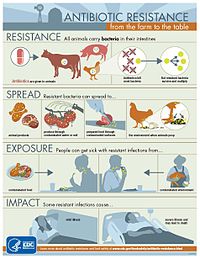
Photo from wikipedia
Salmonella is a group of bacteria that constitutes the leading cause of diarrheal diseases, posing a great disease burden worldwide. There are numerous pathways for zoonotic Salmonella transmission to humans;… Click to show full abstract
Salmonella is a group of bacteria that constitutes the leading cause of diarrheal diseases, posing a great disease burden worldwide. There are numerous pathways for zoonotic Salmonella transmission to humans; however, the role of companion animals in spreading these bacteria is largely underestimated in China. We aimed to investigate the prevalence of Salmonella in pet dogs and cats in Hangzhou, China, and characterize the antimicrobial resistance profile and genetic features of these pet-derived pathogens. In total, 137 fecal samples of pets were collected from an animal hospital in Hangzhou in 2018. The prevalence of Salmonella was 5.8% (8/137) in pets, with 9.3% (5/54) of cats and 3.6% (3/83) of dogs being Salmonella positive. By whole-genome sequencing (WGS), in silico serotyping, and multilocus sequence typing (MLST), 26 pet-derived Salmonella isolates were identified as Salmonella Dublin (ST10, n = 22) and Salmonella Typhimurium (ST19, n = 4). All of the isolates were identified as being multidrug-resistant (MDR), by conducting antimicrobial susceptibility testing under both aerobic and anaerobic conditions. The antibiotics of the most prevalent resistance were streptomycin (100%), cotrimoxazole (100%), tetracycline (96.20%), and ceftriaxone (92.30%). Versatile antimicrobial-resistant genes were identified, including floR (phenicol-resistant gene), blaCTX-M-15, and blaCTX-M-55 (extended-spectrum beta-lactamase genes). A total of 11 incompatible (Inc) plasmids were identified, with IncA/C2, IncFII(S), and IncX1 being the most predominant among Salmonella Dublin, and IncFIB(S), IncFII(S), IncI1, and IncQ1 being the most prevailing among Salmonella Typhimurium. Our study applied WGS to characterize pet-derived Salmonella in China, showing the presence of MDR Salmonella in pet dogs and cats with a high diversity of ARGs and plasmids. These data indicate a necessity for the regular surveillance of pet-derived pathogens to mitigate zoonotic diseases.
Journal Title: Antibiotics
Year Published: 2022
Link to full text (if available)
Share on Social Media: Sign Up to like & get
recommendations!